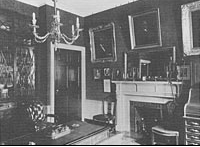The headquarters of the Colonial Society at 87 Mount Vernon Street, Boston, is an important Beacon Hill landmark, having been built by the famous architect Charles Bulfinch in 1807. Unfortunately because of our small staff, we are unable to open it to the public, but we happily provide the following information written by Elton Hall, our curator. Please click here to read the entire article in PDF Format.
The Colonial Society's House
87 Mount Vernon Street, Boston
by Elton W. Hall
 87 Mount Vernon Street, ca. 1940, courtesy of Thomas M. Paine |
IMAGINE that it is the year 1806. You are standing on the front steps of the house recently completed by Charles Bulfinch for Stephen Higginson, Jr., at Mount Vernon, or more precisely just west of the site on which the knoll known as Mount Vernon had lately stood. Aside from the other half of the double house at which you stand and the house built in 1801 for Harrison Gray Otis next door, you see few buildings as you look out over an expanse of open land to the south and west sloping down to the Back Bay where the waters lap at the foot of the hill only a few hundred feet away at the edge of newly constructed Charles Street.
As late as the 1790s the western and southern slopes of Beacon Hill were largely pasture lands. With the construction of the Charles River Bridge in 1786 and three others in subsequent years, the situation changed dramatically as the district became a thoroughfare. The north slope, facing navigable water, had been developed much earlier and was occupied by wharves, maritime tradesmen, rope walks, and sailors' boarding houses where such boisterous and ribald entertainment took place as to earn that district the unflattering name of "Mount Whoredom."1
About that time the state government had outgrown the old Town House, and a plan was approved to purchase a tract of pasture land from John Hancock's heirs on the slope of Beacon Hill for the construction of a new State House to plans drawn by Charles Bulfinch. The cornerstone was laid on 4 July 1795 and the building occupied 11 January 1798.2
 Library, ca. 1900, courtesy of Thomas M. Paine |
Harrison Gray Otis, a member of the town committee that had purchased the Hancock pasture, realized that the presence of the government would change the character of the area dramatically, offering the possibility of a highly respectable residential neigh-borhood. Much of the upland pasture on the south and west slopes of the hill was owned by John Singleton Copley who had been residing in England for the previous twenty years. Forming with Jonathan Mason, Dr. Benjamin Joy, and Hepsibah Swan, a group known as the Mount Vernon Proprietors, Otis arranged with Copley's agent to purchase the entire tract at the rate of $1,000 per acre. Unhappy with the agreement, Copley sent his son, later Lord Lyndhurst, the Lord Chancellor of England, to try to break the commitment. Copley, however, found that Mr. Otis had taken care of all the technicalities and was compelled to sell the property for $18,450.3
The proprietors also acquired pastures from Charles Allen and the heirs of Enoch Brown making in all a tract bounded westerly by the Charles River, southerly by Beacon Street as far as the east side of Walnut Street, easterly by the east side of Walnut to the corner of Walnut and Mount Vernon Streets, southerly again by the south side of Mount Vernon Street to the corner of Mount Vernon and Joy Streets, easterly again by Joy Street, and northerly by a line about seventy feet north of Pinckney Street back down to the Charles River.4 This was such an extensive tract of land that thirty years were to pass before the land west of 89 Mount Vernon Street was laid out.
1. Walter Muir Whitehill, Boston, A Topographical History (Cambridge,1968), p.7-8.
2. Whitehill, p. 59.
3. Samuel Eliot Morison, The Life and Letters of Harrison Gray Otis, Federalist (Boston, 1913), p.42-43.
4. Massachusetts Supreme Judicial Court, Lucy Valentine vs. W. P. Mason et als., 1890. Petitions 4331 and 4229. A printed brief gives a thorough history of ownership of the properties.
Please click here to read the entire article in PDF Format.
